I tried making Guy Fieri's signature recipes for a week, and I didn't love my whole trip to Flavortown
Lara Walsh

- For one week, I recreated seven of Guy Fieri's signature recipes and favorite go-to meals to see if they lived up to their hype.
- I was surprised by the number of ingredients required for the dishes, making some recipes more expensive and time-consuming than I had anticipated.
- Some dishes, like the Texas French toast bananas foster, were well worth the extra effort and will become a regular part of my cooking arsenal.
- Others, like the Texas chili, were disappointing, especially considering the amount of work that went into them.
Food Network personality and restaurateur Guy Fieri has established himself as the "Mayor of Flavortown" with his unique brand of down-to-earth humor and non-pretentious, yet elevated, American cuisine.
Fieri's eccentric style has become iconic, and his twists on classic recipes like mac and cheese and chili are well-known among fans.
To put some of these memorable dishes to the test, I decided to give two breakfasts, two lunches, two dinners, and one dessert from Fieri's arsenal a try to see if they were really as good as advertised.
Keep scrolling to see how my week of cooking Fieri favorites went.
Day one: I tried making his Italian meatball sliders, which are served on Hawaiian rolls.
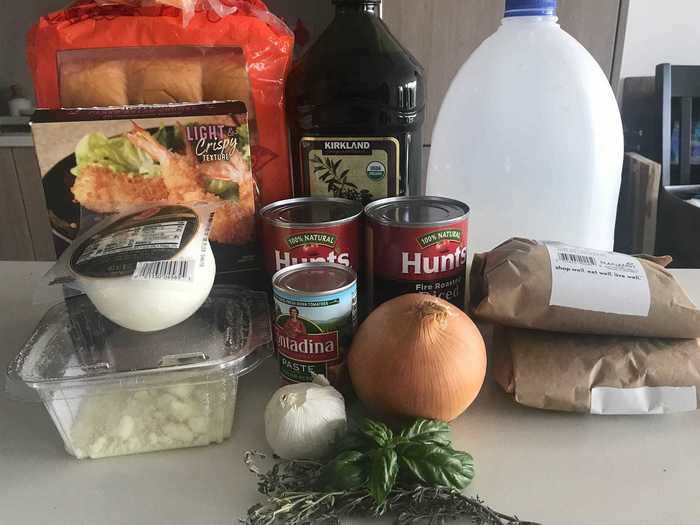
At first glance, I was expecting to be blown away by this recipe since Fieri recommended using fire-roasted tomatoes, fresh basil, and fresh thyme for the sauce.
The recipe also requires Panko crumbs, a 50/50 blend of ground pork and ground beef, and grated parmesan, plus garlic, parsley, and salt and pepper for seasoning.
To start, I cooked onions, garlic, and red pepper flakes in olive oil before adding tomato paste, tomatoes, fresh basil, thyme, water, and some salt and pepper. I let that simmer for about 15 minutes.
Meanwhile, I soaked the Panko in milk for 10 minutes to get it to the right consistency before adding the ground meat, parmesan cheese, parsley, garlic, and some salt and pepper to taste.
I then formed the mixture into eight pretty giant balls and sautéed them for about eight minutes per side before putting them into an oven dish over half of the tomato-sauce mixture. I put the rest of the sauce on top and added eight slices of mozzarella cheese.
Assembling and eating the sliders was harder than I expected it to be.
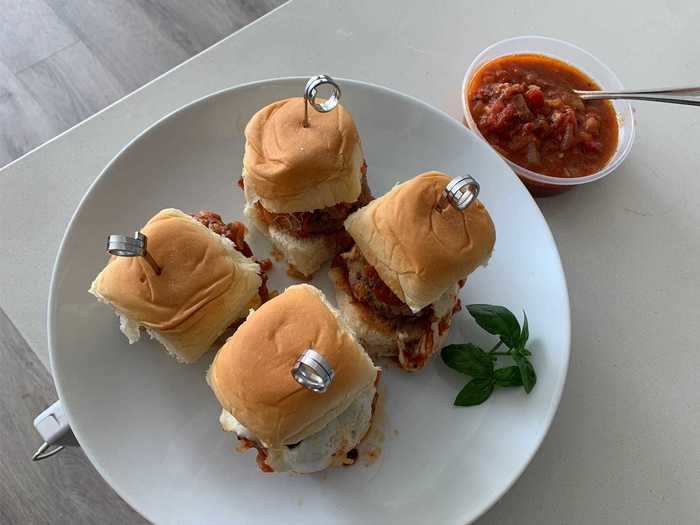
After baking my meatballs in the sauce for 25 minutes, I tried to build the sliders with the help of wooden skewers.
But the assembly process wasn't easy.
The meatballs were almost too large to fit on the Hawaiian buns, and I wasn't able to load them up with much sauce. This was unfortunate because the meatballs were surprisingly disappointing when they weren't covered in sauce.
I also noticed that the ratio of sauce to meatballs seemed off. If I was to make this again, I think I could make half the amount of sauce and still have plenty.
The toppings quickly made the breading soggy, so I had to eat these quickly to prevent the rolls from dissolving into a mushy mess.
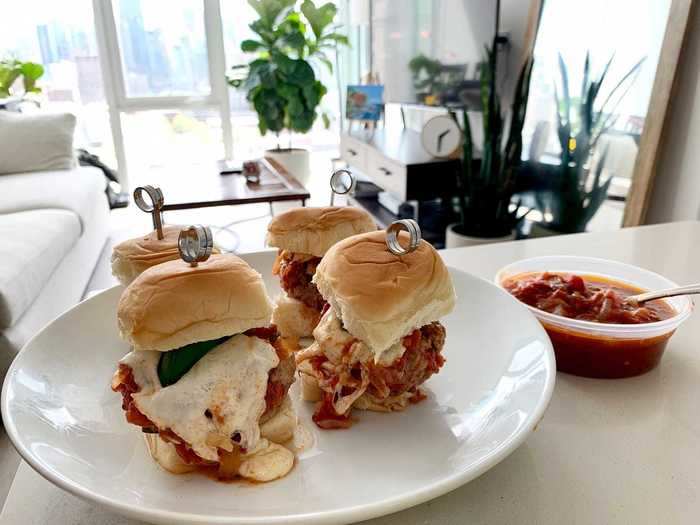
Unfortunately, I assembled most of the sliders right away, so I had to push away the soggy breading the next day.
All in all, I'd recommend eating these sliders as soon as they're done and making sure there's plenty of dipping sauce to serve them with.
The sauce was absolutely my favorite part of the whole dish, and I was tempted to drink it, slurp it, and inhale it by itself once the sliders were gone.
Day two: I attempted Fieri's "Mac Daddy" mac 'n' cheese, one of the dishes I was most excited about.
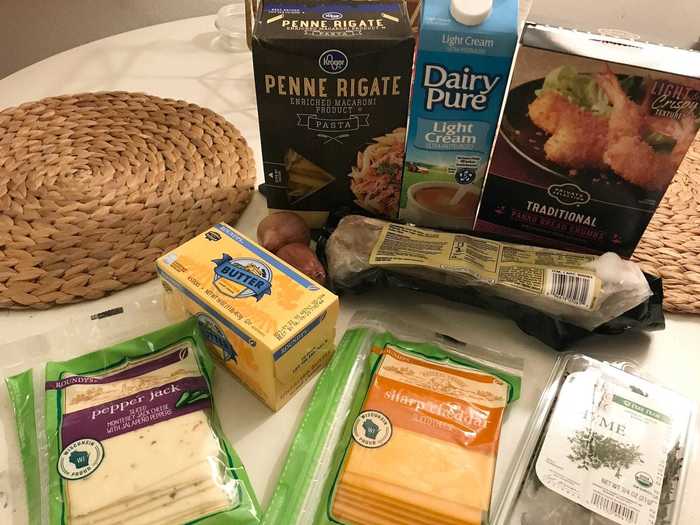
I was surprised by how many ingredients the chef uses to make a classic mac and cheese. In addition to requiring bacon, heavy cream, shallots, garlic, butter, and fresh thyme, Fieri's recipe also needs pepper-jack and cheddar cheeses.
First, I put shallots, garlic, and olive oil in an aluminum-foil pouch and roasted it for half an hour.
The directions also told me to use "reserved bacon fat" to sauté the cooked shallot and garlic mixture instead of instructing me to make the bacon first, which I thought was pretty confusing.
I quickly fried some bacon on the stove, set aside the fat, and used it to further fry the shallots and garlic before adding flour to make a roux. After one minute, I whisked in all the heavy cream and fresh thyme and let it cook until it was reduced by a third.
I also cooked a pound of penne pasta on the side while I was waiting for the sauce to reduce.
Next, I stirred in the cheeses, sprinkled in some salt and pepper, and added the pasta. The whole mixture looked creamy and cheesy and smelled like heaven.
I poured the whole thing into a casserole dish and topped it off with the cooked bacon, Panko bread crumbs, butter, and fresh parsley.
Finally, I baked the dish at 350 degrees Fahrenheit for 20 minutes.
The final result was definitely a bit of a letdown, and it was mushy and unappetizing when I tried reheating the leftovers.

Surprisingly enough, the mac and cheese was extremely bland. All I could really taste was the heavy cream and the bacon on top.
Despite the expensive list of ingredients and all the time I'd put into making the dish, I was disappointed that the different cheeses, fresh herbs, and roasted shallot didn't really come through.
The next day, I quickly learned that the dish didn't improve with time as the pasta got soggy and the toppings hardened.
I decided to throw the rest of it out after eating it on the second day.
Day three: Fieri's stuffed, double-cut pork chops seemed intimidating to make.
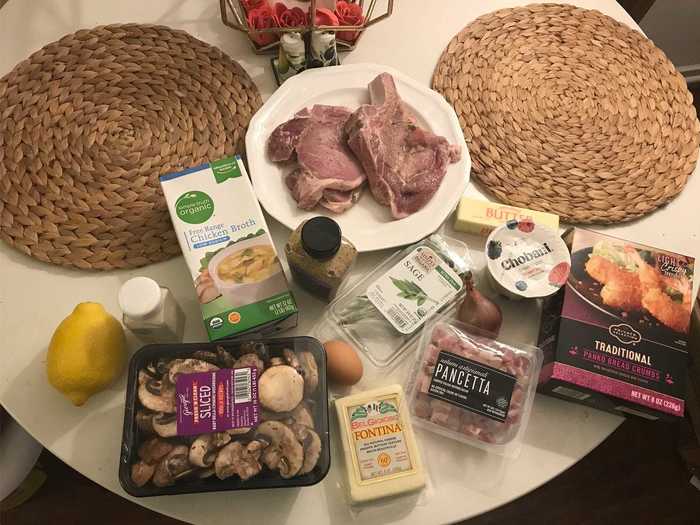
This recipe definitely fueled my curiosity because of its unusual flavor combinations.
To start, I cut a pocket in each one of the pork chops and put them in a plastic bag to brine with water, kosher salt, black pepper, Dijon mustard, dried sage, and granulated garlic for two hours.
Next, I fried the pancetta in an oil and butter mixture, which seemed excessive with all of the grease the meat generated by itself. Then, in the remaining oil, I cooked mushrooms, shallots, sage, and half of the fried pancetta to the pan for a few more minutes.
After the filling cooled, I added the fontina cheese and stuffed the brined pork with the mixture then set aside the rest with the remaining diced pancetta.
While my oven preheated, I beat two eggs in one bowl and mixed Italian seasoning, pepper, Panko, and flour in another.
In that same sauté pan from earlier, I used olive oil (I didn't have any bacon fat like Fieri suggested) to brown the sides of the pork chops that I'd dipped in the breading mixture. I used tongs to hold them together while they cooked.
While the pork was in the oven, I made sauce from the shallots, remaining filling, chicken stock, Dijon mustard, and yogurt.
I finished off the sauce with salt and lemon juice, then poured it on top of the chops along with the remaining pancetta.
Much to my surprise, the seemingly random flavors and textures were amazing together.
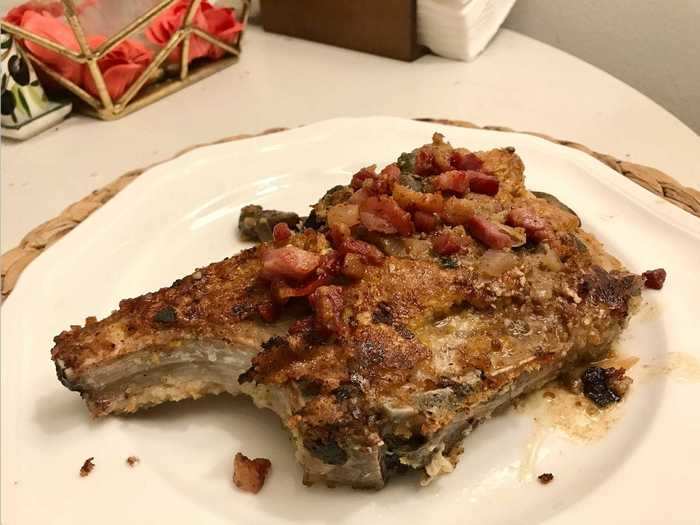
This turned out to be Fieri's biggest dark-horse recipe for me. The crunchiness of the breading paired with the tender meat and all the different flavor combinations made it a big win in my book.
I really liked the sauce — the tangy and citrus elements helped cut some of the richness of the dish.
The chops also held up surprisingly well overnight. Although the breading was a little bit soggy, it still tasted great after I blasted it in the microwave the next day.
This is a recipe I wouldn't mind making again.
Day four: The country ham with stone-ground grits and red-eye gravy was definitely the easiest recipe I attempted all week.
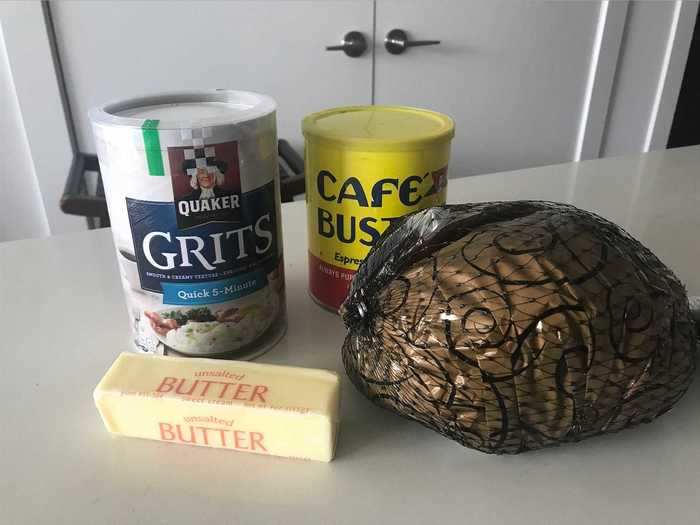
Although this recipe doesn't come straight from Fieri, he has said that it's one of his favorites and he frequently makes it for breakfast.
I was a little skeptical about how bare-bones the ingredients were and the concept of a so-called "coffee gravy," but I decided to give the recipe a try.
First, I put a pot of coffee on, then I started working on the grits. After bringing my water to a boil, I simmered the grits for 45 minutes, stirring frequently to prevent sticking.
While the grits were cooking, I seared the ham for about five minutes per side in a skillet over medium heat until it was browned. Once it was done, I removed it and put a 1/4 cup of coffee with a cup of water in the skillet to simmer until it was reduced by half.
To serve, I put the grits into a bowl with black pepper and butter, followed by the ham, and finished off with spoonfuls of the coffee-gravy mixture.
The ham was good on its own, but I wasn't overly impressed by the grits or the gravy.
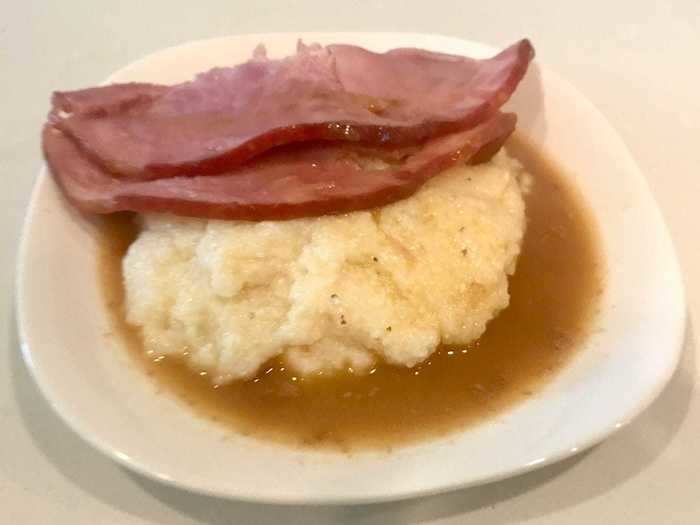
Considering I usually have grits served with cheese, I found this version to be pretty bland. I also noticed that the grits hardened pretty quickly, making it difficult to keep them as leftovers.
The coffee gravy didn't add much flavor to the dish, either. It just made it taste sort of bitter.
Day five: I made Fieri's Texas French toast bananas foster.
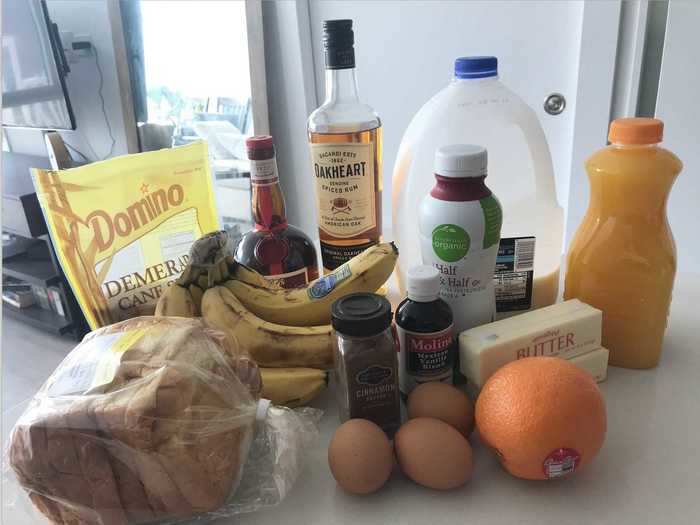
I'm someone who will always choose a savory breakfast over a sweet one, but I'm looking forward to switching things up with Fieri's Texas French toast bananas foster.
It's been years since I've made French toast, but I noticed that Fieri's batter looked like a slightly richer version of what I'm used to with its heavy cream, whole milk, and three whole eggs.
I started by whipping the eggs, milk, and heavy cream in a bowl. I added vanilla extract, Grand Marnier liqueur, sea salt, and ground cinnamon.
Next, I heated up the butter, brown sugar, cinnamon, and orange juice and took it off the burner to add 1/4 cup dark rum.
The directions weren't clear about how much longer I was supposed to leave it on, so I reduced it to low heat and kept stirring until it got to a caramel consistency. Then, I added the sliced bananas to the warm mixture.
Meanwhile, I dipped slices of brioche bread into the batter and cooked them for about two minutes per side. Once they were done, I assembled everything and poured the caramel sauce with the bananas on top.
I was in heaven as soon as the first bite of this hit my mouth.
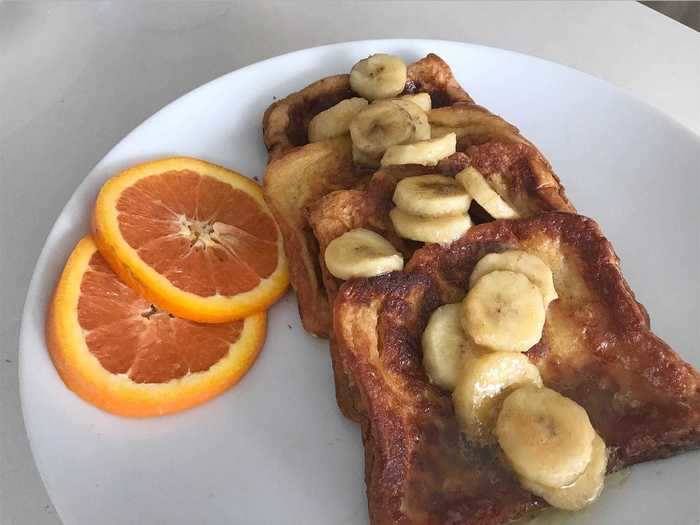
I can say with 100% confidence that I've never had a better bananas-foster French toast.
The citrus flavors from the addition of the Grand Marnier and the orange juice really come through, and it's hard to beat the combination of brown sugar, cinnamon, butter, and fluffy brioche with caramelized bananas.
I did, however, notice that the amount of sauce was a bit of an overkill, so I'd probably make half of it next time.
I'd also recommend making a fresh batch instead of reheating leftovers. The brioche kind of deflated after being in the fridge, so it wasn't as good the next day.
Day six: The Texas chili was easily the most labor-intensive recipe of the week.
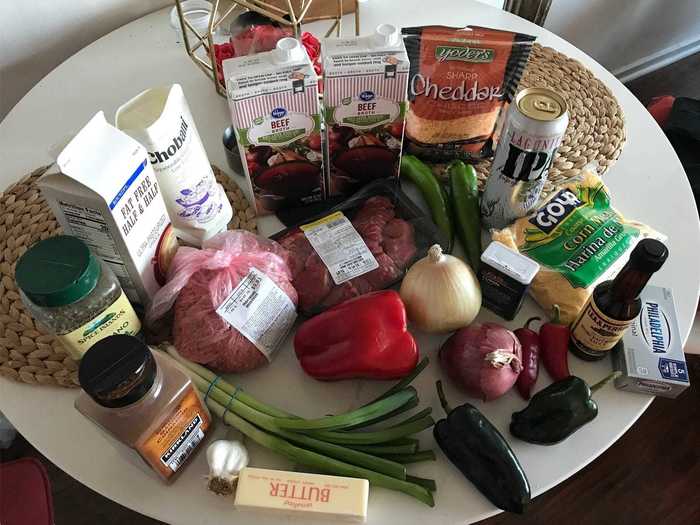
Of all of the recipes I tried this week, Fieri's Texas chili was the one I was most excited to sample.
Instead of using chili powder to give the dish its trademark flavor, Fieri's recipe calls for a homemade paste using ancho, arbol, and guajillo chilis — which you toast, steam, and purée until smooth.
After blending the chilis and setting them aside, I sautéed the onions, peppers, Anaheim peppers, and Fresno chilis in a pan with olive oil for about seven minutes.
Next, I put the chuck and ground beef, which I'd seasoned with salt and pepper, in a separate, deeper pan. I cooked both until they were well browned, then added garlic, cumin, oregano, cayenne, and cinnamon.
Then, I added the cooked vegetables, beef stock, and blended chilis and brought the whole mixture to a boil.
After about two hours, I added the beer, paprika, and masa harina (corn flour), and stirred the mixture for about 12 minutes before sprinkling some salt and pepper on top.
At this point, I noticed that there seemed to be a layer of oil forming, but I tried to mix it up so it was less noticeable. It also looked a lot more watery than the chili I'm used to.
Meanwhile, I started making the beer-cheddar-cheese sauce by cooking unsalted butter, flour, half-and-half, amber beer, cheddar cheese, cream cheese, and Worcestershire sauce. Once everything was melted together, I added salt, pepper, dry mustard, paprika, and cayenne pepper.
I poured this cheesy mixture on top of a bowl of chili before adding a little bit of sour cream, fresh green onions, and diced red onion.
Disappointingly, the end result tasted like hamburger soup.

Although this was one of the dishes I was most excited about, I think it ended up being the biggest letdown.
Not only was making the chili very time-intensive and expensive, but also the flavor just didn't make it worth the effort at all. Additionally, the beer-cheddar-cheese sauce was very rich and didn't seem to add much to the whole dish.
The worst part was eating the leftovers.
I usually think chili improves with time, but there was an unappetizing layer of grease on the top of the mixture that I had to scrape off before reheating. Even then, the whole soup seemed to have an oily texture that made me not want to eat it.
I definitely won't be making this again.
Day seven: Fieri's Cin-ful peach cobbler sounded like a sweet way to end the week.
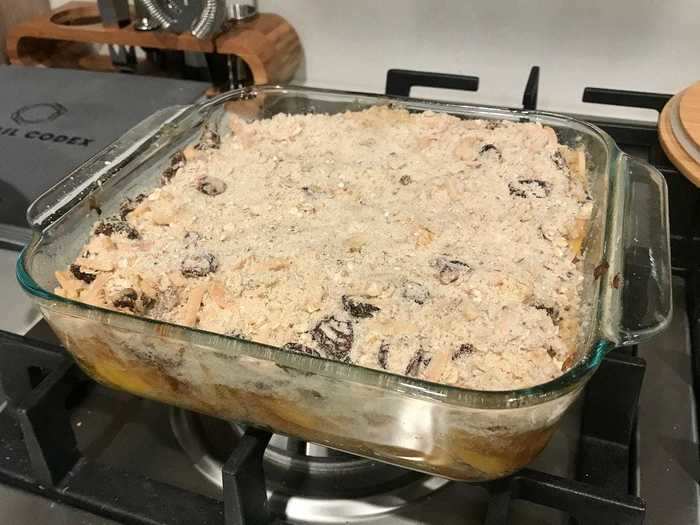
I've never made peach cobbler using frozen peaches or dried cranberries, so I was curious to see how Fieri's recipe measured up.
I started the peach filling by mixing brown and white sugar, flour, cinnamon, and salt, and tossing the still-frozen peaches in to coat them.
Next, I made a thickening "slurry" by dissolving a teaspoon of cornstarch into a tablespoon of water and adding the juice of one lemon. This got added to the peach mixture.
After buttering my baking dish and pouring the peach mixture in, I made the crumb topping by mixing brown and white sugar, flour, oats, almonds, dried cranberries, nutmeg, cinnamon, and salt with a stick of unsalted butter.
I put half of the crumb mixture on top of the peaches before popping the dish in the oven and lowering the heat to 350 degrees Fahrenheit
After baking this for half an hour, I layered on the rest of the crumb topping and baked it for another 45 minutes at 325 degrees Fahrenheit.
This dish wasn't a terrible way to end the week, but the cobbler was a little sweet for my taste.
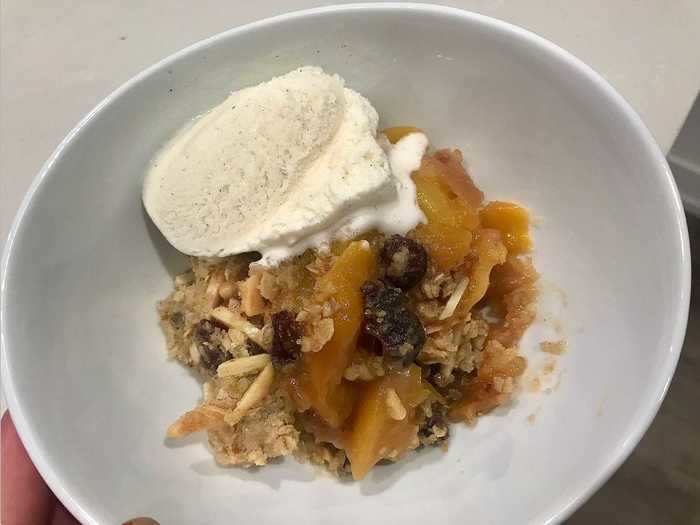
I let the cobbler cool down for about half an hour, then served it with some vanilla ice cream.
The peaches tasted a lot better than expected, but I felt like the dish seemed more like a crisp and wasn't really anything to write home about. I think I'd personally have liked it better if it had a more traditional, flaky crust.
I'm also someone who doesn't like my fruit pies to be too sweet, and all of the sugar in this dish seemed like a bit of an overload.
Conclusion: The Texas French toast bananas foster blew me away, but the Texas chili was the most disappointing dish of the week.

Fieri's Texas chili didn't live up to the hype flavor-wise and featured a lot of ingredients that were expensive and hard to find.
Honestly, I feel like I won't end up using many of the recipes again.
However, I can confidently say Fier's French toast made me more of a sweet-breakfast person than ever before and is definitely going to be part of my brunch arsenal. It wasn't too difficult to make, and all of the flavors really delivered.
Read more:
- I made French toast using 3 celebrity chefs' signature recipes, and the best one cost over $40 to make
- I followed 3 of Meghan Markle's favorite recipes, including 'engagement chicken' — and I was seriously impressed
- 12 things you didn't know about Guy Fieri
- 10 iconic recipes from celebrity chefs that you need to try
READ MORE ARTICLES ON
Popular Right Now
Popular Keywords
Advertisement